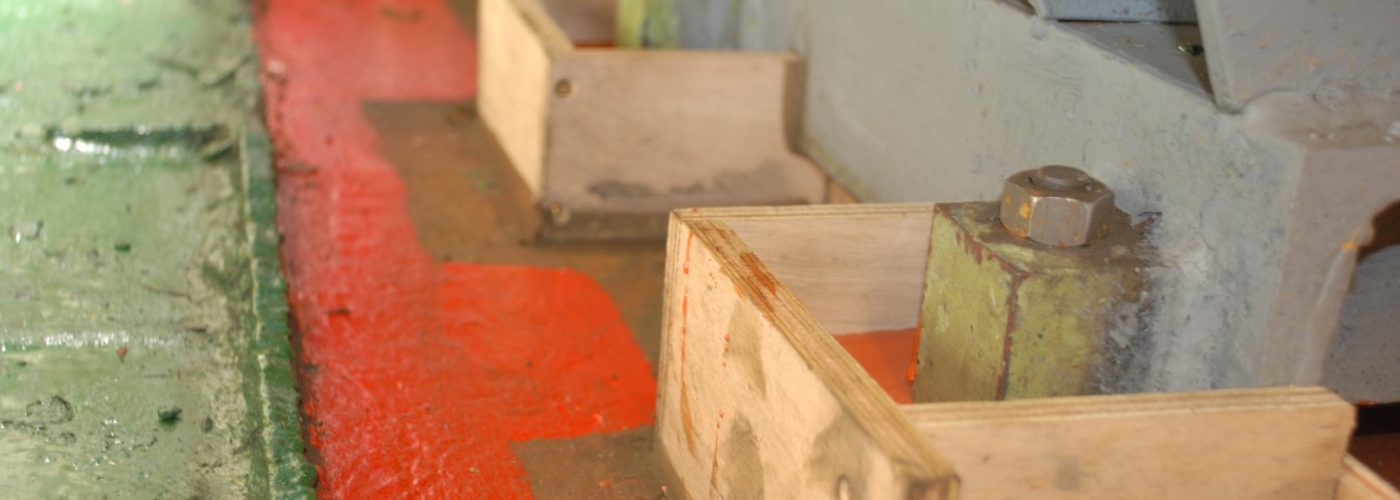At a port operator in the UK, an extremely durable chocking system was required to ensure a new boiler would remain secure and protected, even when subjected to aggressive vibration activity.
Belzona’s Technical Service Engineer, Henry Smith, who assisted with the application said, “Located on a dredger, the boiler was situated just next to the engine room. Due to this proximity, the operator required the chocking system to exhibit exceptional impact resistance in order to withstand constant vibration attack caused by the engine machinery. A further requirement was for the application to be carried out as quickly as possible, ensuring minimal downtime was incurred and therefore minimal profit loss.”
Bad Vibrations
The long-term success of any chocking installation is determined by how well the machinery system is joined to the foundation. The base plate of the machinery system must become a monolithic member of the foundation system in order to ensure minimal vibration activity is achieved. If this system is insufficient, excessive vibration can lead to machinery failure; bolts can become slack, and in more severe cases, equipment can become misaligned.
A conventional chocking solution commonly employed to combat vibrations is metal shimming. However this technique can often be difficult to install and can loosen over time. Another option involves cement grouting, but not only does cement have poor mechanical properties, this method can incur significant cure time and will therefore require longer downtime.
Belzona Specification
Following a Belzona inspection, the operator decided to chock the boiler into place using Belzona 7111 (Marine Grade). This two-component material is specially designed for use as a chocking or grouting compound to endure the physical and thermal shock common to marine environments. DNV GL approved and certified by major classification bodies including Lloyd’s Register Marine and the American Bureau of Shipping, Belzona 7111 is the ideal solution to withstand the damaging vibrations on the dredger.
The simple pouring method enables the application to be carried out with minimal downtime, while the high impact properties of the material will ensure the boiler will remain secure for the long term. In fact, when the impact resistance was tested using Izod Pendulum impact testing in accordance with ASTM D256, Belzona 7111 achieved 0.75 J/cm (un-notched). This indicates that when the chocking material is subjected to impact forces, the material will successfully absorb the shock, thus minimising the impact damage.
Simple Application Method
The boiler was set into place using jacking bolts, and dams were built around each of the individual bolts in order to ensure a restricted chocking area. Belzona 7111 was then poured into the prepared areas.
Due to the way in which the boiler sat inside the engine room, there was limited access underneath which made it difficult to pour the product directly from the mixed unit into the chock area. A small curved steel section was therefore used as a channel to funnel the product, with a thickness of just over 2 inches, into the correct area. Once the application was completed and the system had cured, the dams were removed.
Fast Application and Cure Ensures Minimal Downtime
Dredgers are an important part of the world’s commerce system as much of the world’s goods travel by ship, and therefore need to access harbours or seas via channels. Thus the requirement of a fast-curing chocking material that incurs minimal downtime is critical in insuring this transport method does not become impaired or hindered. In this situation, as Belzona 7111 took just two hours to apply and only 48 hours to cure, this enabled the dredger to successfully continue its operation with minimum downtime and disruption. Furthermore, as Belzona had fully trained the operator and their application team on Belzona chocking applications, this enabled the application to be carried out on site without the need for an external representative; saving the operator unnecessary capital expenditure.





